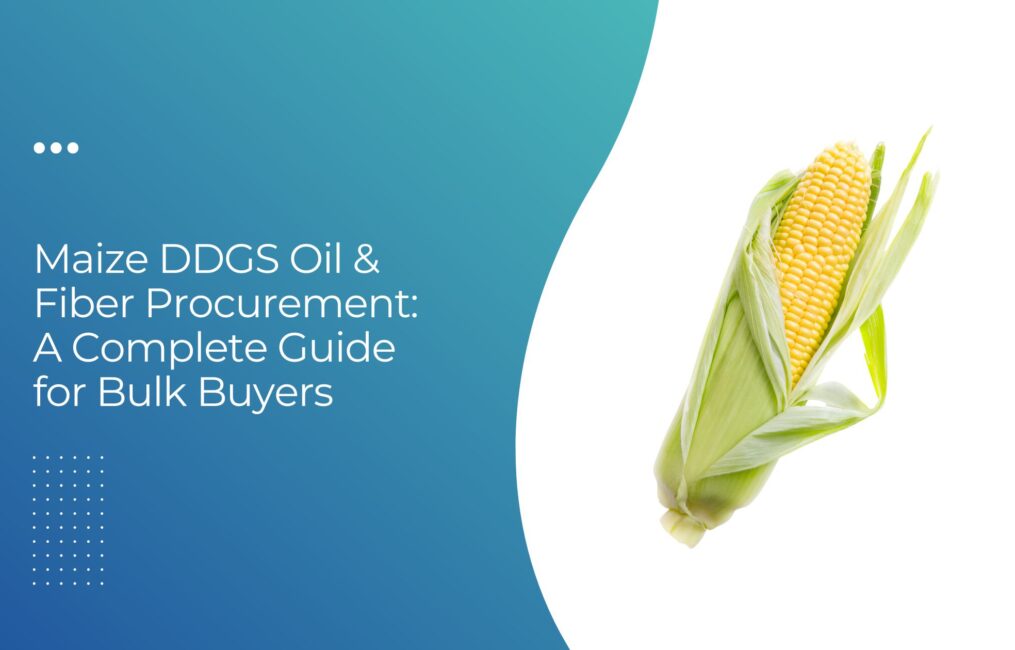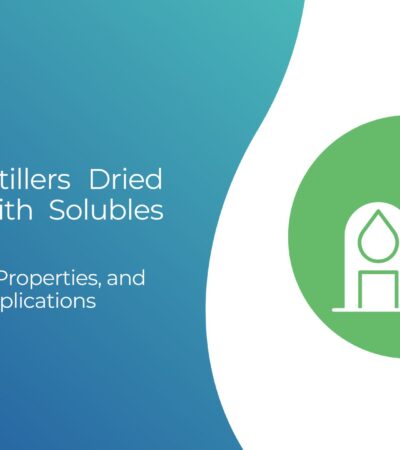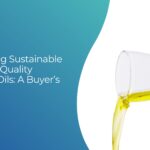Maize DDGS Oil & Fiber Procurement: A Complete Guide for Bulk Buyers

For decades, edible oil has dominated kitchens around the world. And currently, maize DDGS oil is building momentum. As more and more ethanol plants come online globally, producers are tapping this byproduct to deliver added value to the feed and livestock industries. As per recent studies, by the end of 2033, the global DDGS feed market is estimated to hit USD 15,011.42 million, growing at a CAGR of 2.2% during 2025-2033. This market growth is driven by increasing biofuel production and rising demand for efficient feed alternatives.
Hence, for forward-looking businesses, DDGS oil procurement is not just about purchasing. Rather, it’s a strategic move that influences margins, formulation flexibility, and supply stability. Also, the variations in extraction techniques, fiber content, and quality controls make a huge difference.
So, this guide will offer a solid understanding of what maize DDGS oil & fiber are, global market insights, effective procurement practices, quality parameters, and how a reliable partner like Neshiel Agrochem can help.
What is Maize DDGS Oil & Fiber Procurement?
Maize DDGS oil & fiber procurement refers to the process of sourcing and purchasing oil and fiber that are derived from maize-based Distillers Dried Grains with Solubles (DDGS).
Also, maize DDGS is a byproduct of the ethanol production process using corn (maize). When maize is fermented to produce ethanol, what comes out is high in protein, fiber, and oil.
From that process, two valuable products are extracted:
- Maize DDGS Oil – which can be from animal feed, biodiesel production, and in some cases, in industrial applications.
- Maize DDGS Fiber – a high-fiber byproduct which is often used in animal nutrition and feed formulations.
Additionally, Maize DDGS oil & fiber procurement means the structured process of identifying suppliers, evaluating their quality standards, negotiating pricing, and coordinating delivery of these products for industries such as:
- Animal Feed Manufacturing (Poultry, Cattle, Aquaculture)
- Biofuel and Biodiesel Producers
- Food and Beverage Additives (in the case of specialized applications)
- Pharmaceuticals and Nutraceuticals (for fiber extracts)
Basically, maize DDGS oil & fiber procurement is identifying and sourcing these maize-derived byproducts in a way that emphasizes quality, cost efficiency, and steady supply.
Global Market Overview of Maize DDGS Oil & Fiber
Maize oil, derived from corn, plays a vital role in core applications, including food, feed, and industrial uses. Even in cosmetic and personal care products, the rich nutrient profile and soothing properties make it a popular choice. Also, the rising adoption of maize oil in biofuel production presents a new trend in the market, and it is now a valued source of protein for livestock farmers, offering stable prices and enhancing feed efficiency.
Furthermore, the Asia-Pacific region, especially India and China, is a growing global market for DDGS feed and its oil/fiber components. Also, exporting trends are shifting—countries with major ethanol industries (particularly the USA and Brazil) are positioning themselves as dominant exporters, and demand for these products is growing increasingly in regions short on feed.
Now take a closer look at the stat given below:
- In India, the feed-with-solubles (i.e., DDGS) market is expected to grow from USD 177.42 million in 2025 to USD 305.28 million by 2030, at a CAGR of ~11.5% as feed manufacturers strive to reduce costs and become less reliant on imported protein meals.
So, it’s not wrong to say that the maize DDGS oil & fiber market is in a growth phase and supported by global biofuel mandates, enhanced feed needs, and better processing technologies. Businesses can leverage this growing market opportunity and hugely influence their profitability.
Procurement Strategies for Maize DDGS Oil
For risk management, cost reduction, and guaranteeing quality supply, businesses should implement a strategic procurement framework. The following are redefined business strategies aimed at sourcing maize DDGS oil:
1.Choosing Trustworthy Bulk Suppliers
- Businesses should partner with suppliers like Neshiel with a track record of consistency in volumes and quality.
- Check out the certifications (FSSAI, ISO 22000, HACCP, FDA) and also request audited batch records.
2.Balancing Long-Term Contracts and Spot Buys
- Long-term contracts deliver greater stability, better pricing, and a consistent supply.
- Spot purchases allow full advantage of any market dips that are favorable to your position.
- A hybrid approach often works best – contract your base requirement, but leave a portion for opportunistic buys.
Furthermore, quality-based premiums/penalties should always be part of an agreement: if your provider is delivering oil that exceeds the specs you all agreed to, provide a reward, or, if lower than agreed to, provide a downward adjustment.
3.Flexible Delivery Terms & Incoterms
- Businesses should negotiate clear delivery timelines and inspection rights at origin and destination.
4.Leveraging Technology in Procurement
- Advanced analytics tools help forecast demand more accurately. And businesses that use tech tools for procurement gain better cost control, higher consistency, and can make better decisions.
5.Buffer Inventory & Contingency Planning
- Maintain buffer stocks (5–15% of projected demand) to adjust unexpected shortfalls or delays.
- Use this reserve to prevent urgent, overpriced purchases in volatile markets.
Overall, when businesses take a strategic approach to maize DDGS oil procurement, they reduce the risk of quality and get a competitive edge.
Quality Parameters & Spec Details Buyers Should Demand
For DDGS oil procurement, it is important to specify detailed parameters, so check out the list below:
| Factor | Importance | Typical Range/Notes |
| Oil/Fat Content | Let you know the energy value and premium | It might range from 8-12% depending on the process |
| Crude Protein | Feed value for protein content | 27 to 30% |
| Fiber/NDF/ADF | Influence digestibility, gut health | NDF/ADF values should be within agreed limits |
| Moisture (%) | High moisture often leads to spoilage | <10% is often desirable |
| Ash (%)/ Mineral Content | It shows how much non-nutritive load is present. | Should be within acceptable bounds |
| Mycotoxins/Aflatoxin/Toxin | Health & safety compliance | Must fulfill regulatory standards |
| Particle Size | Handling and feed mixing uniformity | Consistent particle size distribution |
| odor/Color/Cleanliness | Sensory checks help flag off issues | No off-odors, acceptable color |
| Residual Solvent | For safety compliance | Zero or below threshold levels |
How Neshiel Helps Businesses in Maize DDGS Oil & Fiber Procurement?
Being a leading maize oil DDGS supplier, we at Neshiel Agroche aim to foster growth with our clients, forging long-lasting partnerships. We bring years of experience and deep knowledge to the table to support manufacturers, food processors, and industrial buyers. Our team puts the client’s needs first, and that’s why they choose us for sourcing maize DDGS oil & fiber.
- End-to-End Procurement Lifecycle Management
We handle a full life cycle with our wide network of verified DDGS oil exporters and suppliers. At every stage, from supplier identification to quality negotiation to logistics to delivery to after-sales.
- Quality Assurance & Documentation
The team at Neshiel prioritises safety, requires CoA, lab tests, and we often commission third-party verification. Also, our documentation includes MSDS, HS codes, etc., all aligned with your import-country requirements.
- Market Insights & Mitigation
We don’t just supply. Rather, we advise. We provide you with trends, insights, price forecasts, and the right sourcing strategies that help you guard against volatility.
- Value-Added Services
We offer comprehensive services and assist our clients in cost optimization, logistics, and packaging, to maintain your product integrity until arrival.
By choosing Neshiel as their maize DDGS oil & fiber procurement company, businesses across the globe gain access to expertise, quality infrastructure, logistics capabilities, and market insights.
Conclusion
Sourcing maize DDGS oil & fiber requires sharp diligence around quality, logistics, and supplier credibility. But when done the right way, businesses gain cost efficiency and reliability for feed formulations.
Also, successful procurement merges three pillars: precise specifications, trusted supplier partnerships, and transparent integrity. And when businesses work with reliable suppliers, they get a competitive edge with better margins. This is where Neshiel Agrochem can help. Being a trusted maize oil DDGS procurement partner, we ensure businesses get their DDGS oil & fiber arrive on spec, on time, and with confidence. We utilize rigorous quality checks, manage sourcing, compliance, CE, and logistics.
So, don’t leave your next big procurement to chance. Share your desired oil & fiber specs, order size, and delivery window, and we will tailor a sourcing plan for you.
FAQs
Q1. Is maize DDGS oil & fiber better than soybean meal?
Well, it depends on price, specifications, and digestibility. Soybean meal is very stable and high in protein, while DDGS has cost advantages and energy from its fat fraction. Usually, these two meals are complementary.
Q2. What is a safe moisture level for DDGS?
Well, usually under 10 is considered safe, but some contracts specify 10-12 percent. However, moisture levels over that may lead to spoilage or fungal events.
Q3. How can you independently test oil/fiber content?
You can have third-party labs complete the analytic testing using accepted testing methods (for example, Soxhlet for fat, NDF/ADF for fiber). And take separate sample splits before shipment, and when it arrives at the lab for completion.
Q4. What is the typical shelf life of high oil DDGS?
Due to increased potential for rancidity from the high oil, the shelf life is shorter, and should ideally be consumed within weeks to a few months, if stored under good conditions (in cool, dry, low oxygen environments).
Q5. Can DDGS fiber be separated or improved?
Yes, if you have access to more advanced separation methods, fractionation or extrusion technologies can partially separate fiber or improve digestibility. However, separating fiber is costly and difficult.



